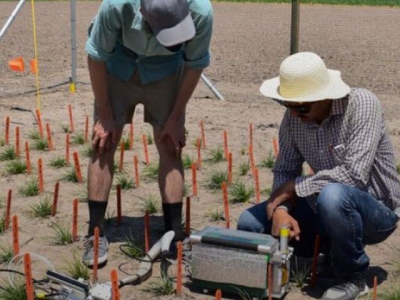Key step forward for game-changing grass

New Zealand researchers developing ryegrass that may boost animal growth and cut methane emissions.
In New Zealand, an important milestone has been reached in AgResearch’s development of a new-generation grass that could prove to be a game changer for agriculture.
With funding from the government of New Zealand and industry partners, including DairyNZ, the genetically modified, high-metabolizable energy (HME) ryegrass has been shown in AgResearch’s laboratories to grow up to 50% faster than conventional ryegrass, to be able to store more energy for better animal growth, to be more resistant to drought and to produce as much as 23% less methane from livestock, AgResearch announced.
Modeling also predicted less nitrogen excreted into the environment by animals feeding on the ryegrass and, consequently, less nitrate leaching and lower emissions of nitrous oxide, another greenhouse gas, according to the announcement.
Development of the HME ryegrass is now progressing in the U.S. Midwest, where genetically modified organisms can be field tested outside the lab, AgResearch said.
After a successful preliminary growing trial last year confirmed that the conditions were suitable, AgResearch principal scientist Dr. Greg Bryan said the full growing trial began in the U.S. last month and will continue for five months.
“The preliminary trial was only two months, so it’s not over a time frame that has any statistical merit; however, we did see the increased photosynthesis that we saw with the plants in the greenhouses in New Zealand,” Bryan said.
“In this full trial now underway, we will be measuring the photosynthesis, plant growth and the markers that lead to increased growth rates. While the growth has previously been studied in glasshouses in pots and as plants spaced out in the field, this will be the first opportunity to assess the growth in a pasture-like situation where plants compete with each other,” he added.
“The five-month time frame will allow us to determine if increased growth is consistent across the summer and autumn, and we will simulate grazing by cutting plants back every three to four weeks,” Bryan said. “Animal feeding trials are planned to take place in two years, which we will need regulatory approvals for, and the information we get over the next two years will help us with our application for those feeding trials.”
Dr Bruce Thorrold, DairyNZ strategy and investment leader for new systems and competitiveness, said the HME ryegrass is a scientific breakthrough and holds great potential for New Zealand farmers.
“HME ryegrass could help us achieve less nitrogen leaching and reduce greenhouse gas emissions as well as improving pasture quality and productivity,” Thorrold said. “This research could be transformational in the future, and so it is important we explore all promising avenues which could help dairy farmers respond to the challenges we face.”
Related news
 MM Mega Market honours Đà Lạt farmers
MM Mega Market honours Đà Lạt farmers MM Mega Market Vietnam presented badges of honour to 20 farmers for being its partners for 10 years in the Đà Lạt Vegetable Platform.
 Cow breeding yields high income for farmers in Tiền Giang
Cow breeding yields high income for farmers in Tiền Giang Farmers who breed oxen and raise cows in the Cửu Long (Mekong) Delta province of Tiền Giang have greatly improved their income.
 Higher price for tea exports offsets dip in volume
Higher price for tea exports offsets dip in volume Despite a decrease in export volume, the average price of exported tea has been on the rise across most markets in the first months of 2018.